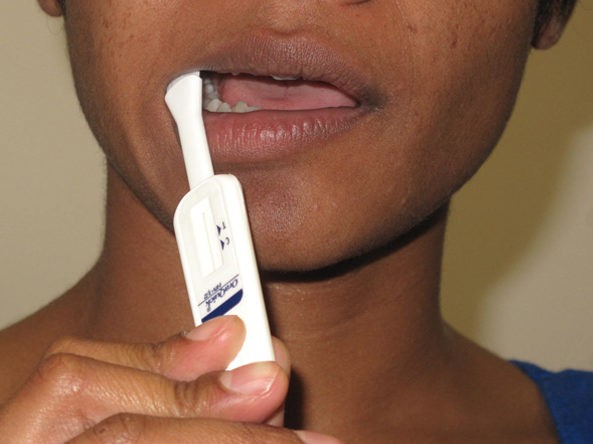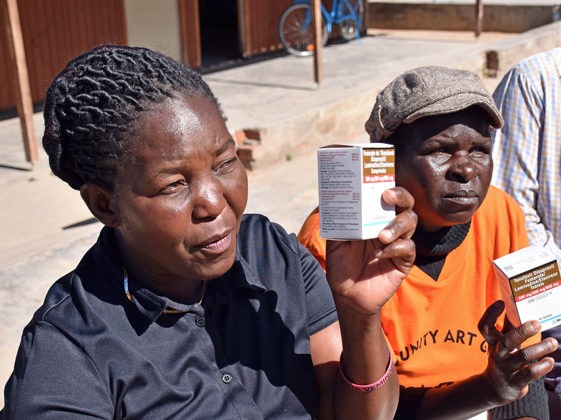Article and Study Summary
Effect of a differentiated service delivery model on virological failure in adolescents with HIV in Zimbabwe (Zvandiri): a cluster-randomised controlled trial.
Published in:
Lancet Glob Health. 2020.
https://doi.org/10.1016/S2214-109X(19)30526-1
Authors:
Mavhu W, Willis N, Mufuka J, et al.
Summary:
This cluster-randomized controlled trial evaluated the effectiveness of the Zvandiri differentiated service delivery (DSD) intervention on HIV-related clinical and psychosocial outcomes among adolescents living with HIV in rural Zimbabwe. Sixteen clinics were randomized to either receive the peer-led, community-based Zvandiri program or the standard HIV care. Adolescents aged 13-19 who were living with HIV and receiving antiretroviral therapy at the trial clinics were eligible to participate. All participants received HIV care per the national guidelines. At the intervention clinics, adolescents and their caregivers received additional support services primarily through community adolescent treatment supporters. This additional support was multi-faceted, based on the adolescent’s needs and included peer counseling, home visits, calls, text messages and group sessions. The trial found a lower prevalence of virological failure or death among adolescents in the intervention group after 96 weeks. Cost analyses found the intervention to be significantly more expensive than the standard HIV care, which may be a barrier to scale-up of this intervention in resource-constrained settings. Nonetheless, this study adds to the evidence supporting a comprehensive, DSD approach that is specific to adolescent needs, in order to improve outcomes in this vulnerable, priority population.
Discussion Questions:
- How could the findings in this study impact the approach to providing services for adolescents living with HIV where you work?
- How could these findings be applied in programs you work with? Do you have any experiences to share?
Please share your thoughts and experiences with us in the comments section below.
Full Synopsis:
PDF version available in English, Portuguese, and French.
Study Summary
This cluster-randomized controlled trial evaluated the effectiveness and cost of the Zvandiri differentiated service delivery intervention on HIV-related clinical and psychosocial outcomes among adolescents living with HIV in Zimbabwe.
Study Setting
- 16 public primary care clinics in two rural districts in Zimbabwe with low antiretroviral (ART) coverage among adolescents living with HIV (about 29 percent).
Methods
- Clinics were eligible for inclusion if they had at least 20 adolescents enrolled in HIV care and were geographically separated by at least 10 kilometers.
- Adolescents were eligible for inclusion if they were living with HIV, registered for HIV care at one of the trial clinics, aged 13–19 years, starting or already on ART, able to provide informed assent, and their caregiver was able to provide informed consent (for adolescents <18 years old).
- Exclusion criteria were being too physically unwell to attend clinic, evidence of psychosis, or inability to provide informed assent or consent.
- Clinics were randomly assigned (1:1) to receive either enhanced ART adherence support through the Zvandiri program (intervention group) or the standard of HIV care (control group).
- Adolescents in the control group received adherence support per national guidelines by adult counsellors and nursing staff, with clinic visits every three months following ART initiation, and CD4 monitoring every six months.
- Participants in the intervention group received standard care plus the Zvandiri intervention:
- Adolescents living with HIV aged 18–24 years were trained as community adolescent treatment supporters and provided adherence counselling and support at clinic visits and through ongoing individualized community-based support.
- Up to ten participants were assigned to a community adolescent treatment supporter and were followed up through text messages, phone calls, home visits, and during their clinic reviews. The type and frequency of contact was determined following assessment of their individual situation:
- Adolescents with a viral load (VL) of <1000 copies/milliliter and/or CD4 count >200 cells/microliter, and attendance at all scheduled clinic visits in the past three months were offered ‘Zvandiri standard care’, consisting of a home visit once a month, plus a weekly, individualized text message.
- Adolescents with a VL of >1000 copies/milliliter and/or CD4 count <200 cells/microliter, who were at risk of common mental disorders or a major depressive disorder, had not attended one or more scheduled clinic visits in the past three months, had started ART in the past three months, who were pregnant or had other psychosocial challenges were offered ‘Zvandiri enhanced care’. Enhanced care involved two home visits a week, plus weekly phone calls and daily text messages.
- Adolescents were allocated to an intervention level at enrollment and reassessed every three months by community adolescent treatment supporters in conjunction with clinic nurses.
- All participants in the Zvandiri intervention group were invited to a monthly support group, facilitated by a volunteer nurse, teacher, or social worker in conjunction with the community adolescent treatment supporters. A standardized curriculum was used focusing on improving health and treatment literacy, HIV disclosure, resilience and coping strategies, sexual and reproductive health, social networks, and awareness of services.
- Caregivers of adolescents in the Zvandiri intervention group were invited to a monthly 12-session support group, facilitated by the Zvandiri mentor and community adolescent treatment supporters. Sessions focused on improving caregivers’ knowledge, skills, and confidence of HIV and treatment literacy, communication and parenting, and available support services.
- At enrollment, all participants completed a questionnaire, provided a finger-prick blood sample for HIV VL testing and underwent a clinical examination to assess their World Health Organization (WHO) clinical stage.
- Follow-up study visits were conducted at week 42–60 and 96 (endline), during which participants completed a questionnaire, had a blood spot sample taken for VL testing, and were examined for WHO clinical staging.
- As part of a process evaluation, in-depth interviews were conducted with trial participants, caregivers, health care workers, support group leaders and community adolescent treatment supporters, and research staff observed support group meetings, community adolescent treatment supporters’ coordination meetings and caregiver information sessions.
- A cost analysis was done to estimate the annual cost per adolescent treated on ART and per adolescent virally suppressed on ART through intervention and control clinics.
- The primary outcome of interest was the proportion of participants who died or had virological failure (defined as a VL of ≥1000 copies/milliliter at 96 weeks after enrollment).
- Secondary outcomes were the proportion of participants who were not retained in clinic services, who had discontinued ART (stopped medication for >3 months), who had depression, who were at risk of common mental disorders, and who had poor quality of life measures.
Study Population and Follow-up
- Between August 2016 and March 2017, 496 adolescents from the 16 eligible clinics were enrolled, with 212 adolescents enrolled in the intervention group and 284 in the control group.
- At enrollment, the median age of participants was 15 years (interquartile range 14-17), 52% were female, 81% were orphans, 47% had a VL of >1000 copies/milliliter, and 68% had not disclosed their HIV status to anyone other than health care staff or caregivers.
- At 96 weeks, 479 (97%) participants had primary outcome data available.
Primary Outcome
- Virological failure or death at endline was less common in the Zvandiri intervention group than in the control group (adjusted prevalence ratio 0.58, 95% confidence interval 0.36-0.94; p=0.03).
- The effect of the intervention was more pronounced for adolescents with a VL >1000 copies/milliliter at baseline, males, those aged 13-16, and in those who had been on ART for >2 years prior to the intervention.
- There were 28 deaths, including 17 in the intervention group and 11 in the control group.
Other Outcomes
- The intervention had a favorable effect on all secondary outcomes at endline, but the differences between study arms were not significant.
- There were 57 admissions to hospital, including 20 in the intervention group and 37 in the control group.
- Process evaluation and qualitative data suggested that the intervention had positive effects on participants through a focus on shared experiences, role modelling, supportive friendship, improved home and clinic environments, and improved treatment literacy of adolescents and their caregivers. It also demonstrated that text messages, along with other support provided by the community adolescent treatment supporters, provided practical reminders that improved the capacity of adolescents to habituate treatment adherence.
- The total annual cost per adolescent treated with ART was $997.00 through the intervention clinics and $163.17 through control clinics. The annual cost per virally suppressed adolescent on ART was $1340.00 for the intervention clinics and $450.36 for the control clinics.
Critical Analysis
This cluster-randomized controlled trial found a lower prevalence of virological failure or death among adolescents with HIV receiving enhanced ART adherence support through the Zvandiri program than among those receiving standard HIV care. The multicomponent intervention involves differentiated, peer-led, community-based support, and evaluation data suggest that multiple elements of the program contributed to improved adherence outcomes for adolescents. However, the Zvandiri intervention was notably more costly to implement and did not significantly impact other clinical or psychosocial outcomes that were evaluated.
The following points should be considered when interpreting the study findings:
- There was imbalance between study arms at enrollment, with participants in the intervention group more likely to be female, older, not in school, with a more positive caregiver attitude, less likely to have experienced stigma or to have common mental disorders or depression, more likely to have an unsuppressed VL, and with a shorter duration on ART. Age, sex, being in school, baseline VL, and baseline common mental disorders and depression scores were adjusted for in the analyses, but some of the remaining contextual imbalances may have led to an overestimation of the intervention’s effect.
- It was not possible to mask intervention status from the field research team and clinic staff, but statisticians and laboratory staff who assessed the primary outcome were unaware of group allocation.
- This was a resource-intensive intervention, which included the use of regular text messages and was sometimes hampered by network or power outages. Nonetheless, this feature may limit its generalizability to more resource-constrained settings, including settings with lower levels of cellphone coverage among adolescents.
- There was an alarmingly high proportion of deaths in both groups and verbal autopsy findings suggested that six (35%) of 17 deaths in the intervention group and eight (73%) of 11 deaths in control group were due to cessation of ART sanctioned by caregivers and likely motivated by faith healing. This finding underscores the need for contextualized, multi-faceted interventions to support adolescents living with HIV in this context.
- Despite this intensive intervention, 22% of participants in the Zvandiri group did not achieve VL suppression or died, which suggests that additional measures may be required to further improve outcomes in this population.
- Although costs were higher in the intervention group, sensitivity analyses found that the annual cost could be brought down to $602.85 per adolescent treated with ART and $810.00 per adolescent achieving viral suppression, with some adjustments in assumptions relevant to program scale-up.
Implications
This cluster-randomized trial in rural Zimbabwe found a significantly lower prevalence of virological failure or death among adolescents living with HIV who were receiving enhanced ART adherence support through the Zvandiri program than among those receiving standard HIV care. The Zvandiri intervention was multi-faceted and cost notably more than standard care, which may limit its ability to be scaled with fidelity in resource-constrained settings. However, this study adds to the limited evidence on effective interventions to improve HIV-related outcomes in this vulnerable population. Policymakers and HIV programs will have to weigh the short-term costs of such an intervention, with the long-term benefits of improving treatment success in this population.
This article synopsis was written by Cassia Wells. Share your thoughts on this article or suggest an article for Journal Club by emailing her at caw2208@cumc.columbia.edu









